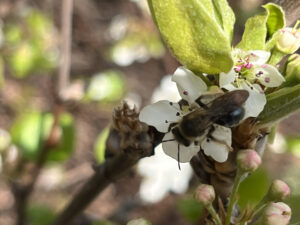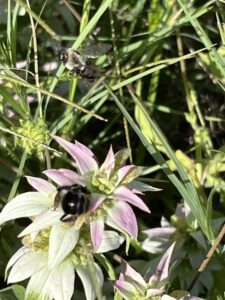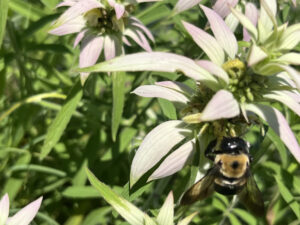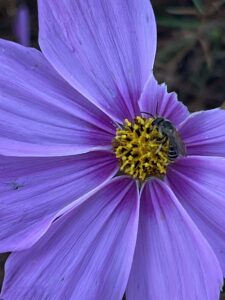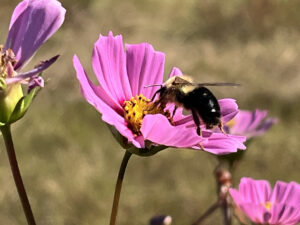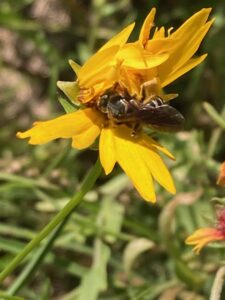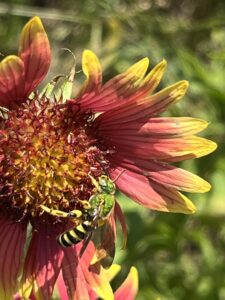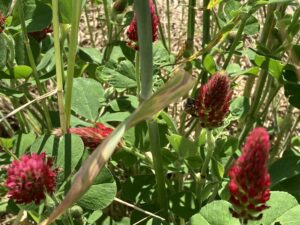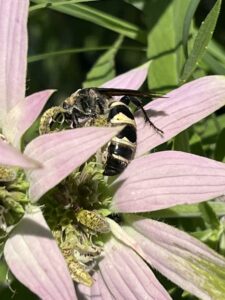Progress report for OS24-172
Project Information
The U.S. food supply is endangered by declines in honeybees and a lack of possible pollinators in the future. Compounding the problem is a loss of native pollinator habitat, global climate change, pollution, and the need to boost production.
The best alternative to honeybees is the native bees already present in the environment [9-15,20]. With nearly 3500 species in North America alone, the diversity of different forms, pollen-strategies, and behaviors of native bees provides a wide range of use for agricultural operations. Relying on several native bee species with varying behaviors and adaptations is a solution to varying climate conditions resulting from global climate change [19].
Past research suggests two main methods of boosting native bees in agricultural areas: (a) providing nesting habitats and (b) providing additional floral resources (particularly during periods of low food availability).
Based on current studies of Eastern Central Georgia (e.g. coastal plain areas with sandy well-drained soils), 3 main habitat enrichments are: (1) season-long food supply, (2) water, and (3) additional nesting areas need boosting.
The farm in this experiment grows blueberries and cucurbits (cucumbers, watermelon, and pumpkins), allowing native bee activity to be measured over the whole growing season. These crops provide a range of flowering times: blueberries (March-April), cucumbers (June-July), watermelon (July), and pumpkin (July-August). The May will be a period of no crop flowers.
Habitat Enrichment Corridor
The first resource to be added to the habitat enrichment corridor is a season-long food supply. Stocking the corridor with different wildflower species will provide a season-long food supply. The most beneficial wildflower plants have been identified as (1) Indian Blanket (Gaillardia pulchella) (2) Black-eye Susan (Rudbeckia hirto), and (3) Swamp Sunflower (Helianthus angustifolius). Several additional wildflower plants will also be tested (e.g. tickseed, asters, mints).
The second resource to be added is water. Current climate patterns in Central Georgia impacted by global climate change indicate very hot summers with few days of rainfall. The lack of water may keep native bees from certain agricultural areas. It should be noted that managed bees, like honeybees, are provided with additional food and water resources at their hives by their beekeepers.
The third resource to be added is nesting habitat. In the Southeastern U.S. region, the most useful native bees are ground nesting bees that could also nest in the wildflower corridors. These ground nesting native bees include Southeastern Blueberry Bees (Habropoda laboriosa), sweat bees (Genera: Augochlorella, Halictus, Lasioglossum), and bumble bees (Genus Bombus). Cavity nesting bees such as Mason Bees (Genus Osmia) may play a role in early season pollination, while leaf cutter bees (Genus Megachile) may also play an important role in pollenating summer flowering crops. Bee houses with nesting tubes will be added to the corridors for cavity nesting bees.
Studies have shown floral enhancements on the edges of orchards and farms have had a significant effect in recruiting or bringing in more native bees. Now, scientists need to explore what is really going on in the wildflower patches during each major period of the growing season. Specifically, we need to know what is going on during the (1) pre-bloom period, (2) bloom period of the target crop, and the (3) post-bloom period/summer dearth period (period of few floral resources).
The main purpose of the proposed study is to assess the habitat enrichment corridors to boost native bee and beneficial wasps over the whole agricultural season. The results of the proposed project will answer:
(1) Which wildflower species are the best at recruiting native bees pre-bloom and during bloom of the blueberries? (Spring period, March -April)
(2) Which wildflower species are the best at maintaining native bees during post-bloom period (a time of no flowers)? (Early Summer, May)
(3) Which wildflower species best support bee populations during bloom of cucurbits (cucumbers, squash, watermelon, and pumpkins)? (Summer/Fall period, June-September)
(4) Which wildflower species are the best at maintaining native bees during post- bloom (a time of no flowers) of cucurbits? (October)
These answers will assist in the development of an ideal wildflower mix that will boost target native bee abundances by providing the correct wildflower resources. These resources will both increase native bee pollination activities within the farm during the current season and will promote greater offspring production, leading to higher abundances of native bees in subsequent seasons.
Each region of the U.S. varies in farming conditions, bloom times, and variety of native bee species available for pollination activities [20,21]. Regional studies such as the proposed study are essential in gathering accurate information on which wildflower species have the best native bee recruitment characteristics.
Past research of Georgia’s native bees has focused on the northern apple producing areas of Georgia. This will be one of the first studies of native bees in Eastern Central Georgia (e.g. coastal plain area with sandy well-drained soils). Thus, the study’s results will also allow a comparison of native bees’ seasonal diversities and abundances between native bees in Northern Georgia (clay soils) versus Eastern Central Georgia (sandy soils).
Other pollinators (including pollinating flies, pollinating wasps, and butterflies) could benefit from the addition of pollinator friendly habitats. Current pollinator studies have identified native beneficial wasp species present in central and southern Georgia farms (personal observation). Specifically, hairy flower wasps (Family Scoliidae) have been observed to occur in large numbers at several different farms.
This group of wasps has been identified as beneficial predators of pest beetles and provide significant pollination of numerous flowers [21]. Thus, this study will also study and survey wasps in addition to the native bees. It should be noted: Scoliidae wasps are not often seen in the North Georgia (clay soils) orchards and farms.
The proposed study plans to examine the following key questions:
- Do habitat enrichment corridors stocked with food, water, and nesting areas increase native bee abundance and diversity?
- Which wildflower species are best at recruiting different target native bee groups?
- Do habitat enrichment corridors stocked with food, water, and nesting areas increase other beneficial insects (e.g. hairy flower wasps)?
To measure the effectiveness of habitat enrichment corridors, we will monitor native bees and beneficial insect abundance and diversity from March to October. This study will be conducted at Pinefield Eco Farm, located in Hephzibah, Georgia. We have gathered 2 years of baseline data on native bee abundance and diversity at this farm.
On the farm, we will create six plots of blueberry bushes (3 control and 3 experimental) and six plots of cucurbits (3 control and 3 experimental). Each experimental plot will have an adjacent habitat enrichment corridor.
Blueberry Plot (Blueberries flower March – April)
The three blueberry “experimental” plots will consist of 5 rows of blueberry bushes roughly 1500 ft2 (50 x 30 feet) with an adjacent habitat enrichment corridor roughly 400 ft2 (50 ft x 8 ft). The three blueberry “control” plots will have the same layout but will lack the habitat enrichment corridor. The blueberry experiment and control plots are separated by a small forest (more than 1000 feet across).
Cucurbit Plots (cucumbers, squash, watermelon, pumpkins) ( Cucurbits flower June-August)
The three cucurbit “experimental” plots will consist of 12 rows: 3 cucumber, 3 squash, 3 watermelon, and 3 pumpkin (roughly 1200 ft2 (50 x 24 feet), with an adjacent habitat enrichment corridor roughly 200 ft2 (50 ft x 8 ft). The three cucurbit “control” plots will have the same layout but will lack the habitat enrichment corridor. The blueberry experiment plots and an additional open area will separate the cucurbit control and experiments plots.
The Habitat Enrichment Corridor (Water, nesting, and food enrichments)
The habitat enrichment corridor will be seeded with 20+ wildflower species. The main wildflower species of interest are: (1) Indian Blanket (Gaillardia pulchella) (2) Black-eye Susan (Rudbeckia hirto), and (3) Swamp Sunflower (Helianthus angustifolius). The goal is to have 3 or more wildflower species blooming in each of the seasons (spring, summer, and fall).
In the center of each habitat enrichment corridor, a bee house with 6 – 9 mm diameter natural reed clusters (300 reeds per corridor) will be placed. Spring bees (e.g. Mason Bees) and Summer Bees (e.g. Leaf Cutter bees) will use this nesting resource. Nest boxes will be 4 feet above the ground on poles. In October, we will assess which diameter size reed worked best.
In the center of the habitat, a bee watering station will be placed next to the nest boxes. We will evaluate 3 types of watering stations (Foxhound 1/2 gallon reservoir, Sunvara 8 oz bee water feeder, and Zavhoz feeding bowl feeder). The 3 types of watering stations will be zip tied to 2 stacked cinderblocks for stability.
Objective 1: Measure native bee and beneficial insect abundance in blueberry and cucurbit plots during each of the 5 major periods of the growing season.
To gather the data needed to test this objective, we will use a range of sampling methods proven to accurately sample native bee abundance and diversity in North Georgia Apple Orchards, based on a modified Bee Inventory Plot Design [11].
This project begins in April 2024. However, we will perform 12 samples each year (March (x2), April (x2), May (x2), June (x2), July (x1), August (x1), September (x1), and October (x1) in each plot. Pre-Bloom Sampling (March), Blueberry Bloom (April), and Post-Bloom/Summer Floral Dearth (May) and Summer Cucurbit Bloom (June, July, August) and Post-Bloom (September, October).
Each of the six plots will be passively sampled using a total of 6 sets of bowl traps (each set consists of 1 UV blue bowl, 1 UV yellow bowl, and 1 white bowl), 2 vane traps, and 1 malaise trap. In addition, active sampling will be performed by timed sweep netting of 30 minutes in each plot.
In each plot, the bowls will be laid out in an “X” formation from the plot’s site corners. One vane trap will be placed on one side of the plot, and the other vane trap will be placed on the opposite side of the plot. The malaise trap will be placed on the edge of the plot in the middle row.
All bee samples collected will be stored in 95% ethanol and taken back to Georgia Gwinnett College. Professor Schlueter will lead 10-12 GGC undergraduates in sorting the samples and identifying the bees. (Most students are from underrepresented groups - See Diversity, Equity and Inclusion grant section below)
Objective 2: Assess the success of each type of enrichment in the habitat enrichment corridor.
Wildflower Assessment
We will assess the success of wildflowers by doing a bee visitation count. Each collection day students will perform a 30-minute timed bee count on the wildflowers. Students will observe and record which species of wildflower had a bee visiting it. If possible, students will take a photograph of the bee for later identification.
Nesting Assessment
Bee houses with 6 – 9 mm diameter natural reed clusters (300 reeds per enrichment corridor) will be placed in each plot. In October, we will assess which diameter size reed worked best by measuring the reed diameter size of each reed and determining if stem nesting bees used the reed for nesting.
Water Assessment
We will evaluate 3 types of watering stations (Foxhound 1/2-gallon reservoir, Sunvara 8 oz bee water feeder, and Zavhoz feeding bowl feeder). Students will observe and record which water station had a bee visiting it. If possible, students will take a photograph of the bee for later identification.
Objective 3: Determine which target bee species is present on specific wildflowers in each of the major periods of the growing season.
There are five major periods of concern: Pre-bloom, Bloom, and Post-Bloom/Summer Dearth (Poor food availability in farms), Summer Cucurbit Bloom (June, July, August) and Post-Bloom (September, October).
Researchers use video cameras to monitor flowering wildflower species. Video cameras will record each bee that lands on a targeted wildflower species. After performing the bee visitation count (objective 2), students and researchers will walk through the habitat enrichment corridor, attempting to photograph and/or collect bees. Collected bees will be taken to GGC for identification.
Cooperators
- - Producer
Research
Study Location
Pinefield Ecofarm in Hephzibah, Georgia was the site of the on-farm research experiments. On the farm, there were six plots of blueberry bushes surveyed (3 control blueberry plots and 3 experimental blueberry plots). Wildflower patches of perennial and annual wildflowers were introduced to the experimental blueberry plots in the summer of 2022 (after the blueberry bloom).
In addition, there were 3 experimental plots (with similar wildflower strips) and 3 control plots that contained squash, cucumbers, watermelons, and other cucurbits. These are referred to as the cucurbit plots. These summer flowering plants (cucurbit plots) were added to the farm in summer of 2023.
Wildflower species seeded in the wildflower strips were: Cosmos Sensation (Cosmos bipinnatus), Lance Leaf Tickseed (Coreopsis lanceolata), Plains Coreopsis (Coreopsis tinctoria), Purple Coneflower (Echinacea purpurea), Siberian Wallflower (Erysimum allionii), Buckwheat (Fagopyrum esculentum), California Poppy Orange (Eschscholzia californica), Indian Blanket Flower (Gaillardia pulchella), Sunflower Lemon Queen (Helianthus annuus), Gayfeather (Liatris spicata), Sweet Alyssum Tall White (Lobularia maritima), Wild Perennial Lupine (Lupinus perennis), Bee Balm (Monarda didyma), Spotted Beebalm (Monarda punctata), Baby Blue Eyes (Nemophila menziesii), Evening Primrose (Oenothera biennis), Red Corn Poppy (Papaver rhoeas), Lacy Phacelia (Phacelia tanacetifolia), Mountain Mint (Pycnanthemum muticum), Yellow Prairie Coneflower (Ratibida columnifera), New England Aster (Symphyotrichum novae-angliae), and Crimson Clover (Trifolium incarnatum).
Each experimental day at the farm (12 per year; March – September), bee observers watched wildflower patches for up to two hours per day. Wildflower effectiveness was defined as a floral visit by a native bee. Video cameras were also used to measure bee visitations. However, in-person bee/flower counts yielded much higher counts of bee- flower interactions.
Bees were sampled using blue, yellow, and white bowl traps, yellow and blue vane traps, malaise traps, and sweep netting.
The Habitat Enrichment Corridor (Water, nesting, and food enrichments)
The habitat enrichment corridor was seeded with 20+ wildflower species. The main wildflower species of interest are: (1) Indian Blanket (Gaillardia pulchella) (2) Black-eye Susan (Rudbeckia hirto), (3) and Swamp Sunflower (Helianthus angustifolius).
In the center of each habitat enrichment corridor, 2 bee houses with 6 – 9 mm diameter natural reed clusters were placed. Spring bees (e.g. Mason Bees) and Summer Bees (e.g. Leaf Cutter bees) will use this nesting resource. Nest boxes will be 4 feet above the ground on poles.
In the center of the habitat, 4 bee watering stations were placed next to the nest boxes. The watering stations will be zip tied to 2 stacked cinderblocks for stability.
Objective 1: Measure native bee and beneficial insect abundance in blueberry and cucurbit plots during each of the 5 major periods of the growing season.
To gather the data needed to test this objective, we used a range of sampling methods proven to accurately sample native bee abundance and diversity in North Georgia Apple Orchards, based on a modified Bee Inventory Plot Design.
Each plot was passively sampled using a total of 6 sets of bowl traps (each set consists of 1 UV blue bowl, 1 UV yellow bowl, and 1 white bowl), 2 vane traps (blue and yellow), and 1 malaise trap. In addition, active sampling will be performed by timed sweep netting of 30 minutes in each plot.
In each plot, the bowls will be laid out in an “X” formation from the plot’s site corners. One vane trap will be placed on one side of the plot, and the other vane trap will be placed on the opposite side of the plot. The malaise trap will be placed on the edge of the plot in the middle row.
All bee samples collected will be stored in 95% ethanol and taken back to Georgia Gwinnett College for insect sorting and identification.
Objective 2: Assess the success of each type of enrichment in the habitat enrichment corridor.
Wildflower Assessment
We assessed the success of wildflowers by doing a bee visitation count. Each experimental day at the farm (12 per year; March – September), bee observers watched wildflower patches for up to two hours per day. Wildflower effectiveness was defined as a floral visit by a native bee. Video cameras were also used to measure bee visitations. However, in-person bee/flower counts yielded much higher counts of bee- flower interactions.
Nesting Assessment
Bee houses with 6 – 9 mm diameter natural reed clusters (300 reeds per enrichment corridor) will be placed in each plot. In October, we will assess which diameter size reed worked best by measuring the reed diameter size of each reed and determining if stem nesting bees used the reed for nesting.
Water Assessment
We will evaluate the success of watering stations based on their bee visitation rates. Students observe and record which water station had a bee visiting it.
Objective 3: Determine which target bee species is present on specific wildflowers in each of the major periods of the growing season.
There are five major periods of concern: Pre-bloom, Bloom, and Post-Bloom/Summer Dearth (Poor food availability in farms), Summer Cucurbit Bloom (June, July, August) and Post-Bloom (September, October).
Researchers used cell phones and video cameras to monitor flowering wildflower species. Cameras will record each bee that lands on a targeted wildflower species. After performing the bee visitation count (objective 2), students and researchers will walk through the habitat enrichment corridor, attempting to photograph and/or collect the bees.
Objective 1: Measure native bee and beneficial insect abundance in blueberry and cucurbit plots during each of the 5 major periods of the growing season.
Here are the results from 2024 (first year of the current SARE grant). The study is ongoing and will be complete March 2026. The research project started on the blueberry farm in 2022.
The number of bees significantly increased in 2024 compared to the previous years (Table 1). The study showed both increases in bee abundance and shifts in the bee community species makeup. The shift favored bee species of larger physical size.
Year 1 of the study (2022) was the control year without wildflowers. Both experimental and control plots did not have wildflowers. In year 1, 590 bees were collected. Most of these bees (89.5%) were the very small sweat bees (Lasioglossum species).
Year 2 of the study (2023) had experimental plots with wildflowers and control plots. There was a significant shift in the bee community. Large-size bees (e.g. Bombus and Xylocopa) and medium-size bees (e.g. Andrena and Habropoda) significantly increased in abundance. For example, mining bees (Andrena species) sampled went from 1.7% (2021) to 7.3% (2022) to 18.8% (2024).
Year 3 of the study (2024) had experimental plots with wildflowers and control plots. Bee abundance showed a significantly increase, and significant shifts in the bee community continued. Year 3 (2024) saw a significant concentration of perennial wildflowers appear (e.g. Spotted Bee Balm). Once again, large size bees (e.g. Genera Habropoda and Andrena) made up a greater percentage of bees in the sample (Table 1).
Objective 2: Assess the success of each type of enrichment in the habitat enrichment corridor.
Table 3 shows that plots with wildflowers had a significantly higher abundance of bees compared to plots without wildflowers. Table 3 highlights the significant shifts to larger size bees. From 2022, blueberry bees (Habropoda laboriosa) increased 20X in abundance, carpenter bees (Xylocopa virginica) increased 23X in abundance, mining bees (Andena species) increased 44X in abundance, and large green sweat bees (Agapostemon species) increased 44X in abundance.
It should be noted that the large-size bees and medium-size bees have been linked to boosting agricultural yield across a wild range of commercially important crops. The pollination value of the small sweat bee has been questioned due to their small size. Thus, if wildflower patches can boost large and medium size bee abundance, then improved agricultural yield should follow.
Objective 3: Determine which target bee species is present on specific wildflowers in each of the major periods of the growing season.
Table 4 shows that wildflowers that recruited the most bees were Spotted Beebalm (Monarda punctata), Indian Blanket (Gaillardia aristata), Lanceleaf Tickseed (Coreopsis lanceolata), and Red Clover (Trifolium pratense). Each of these flowers had 50 or more visits (bee- flower interactions) (Table 6). Spotted Beebalm and Indian Blanket wildflowers were visited by the widest range of bees and had the greatest bee visitation rate.
The results suggest that certain species of wildflowers such as Spotted Beebalm, Indian Blanket, and Lanceleaf Tickseed can significantly alter and boost the wild bee abundance and diversity in agricultural areas. It should be noted that the large-size bees (e.g. Bombus and Xylocopa) and medium-size bees (e.g. Andrena and Habropoda) have been linked to boosting agricultural yield across a wild range of commercially important crops.
An Additional Pollinator of Interest: Scollid Wasps
The sandy soil of the Coastal Plain of Central Georgia has large numbers of the Scoliid wasps. There were 44 Scoliid wasps collected in the sample in 2022 (control year), 108 Scoliid wasps in 2023, and 408 Scoliid wasps in 2024. The addition of wildflower plots is likely to have increased (10x) the abundance of these large wasps at the farm. These wasps were observed interacting with both the wildflowers and blueberry flowers. Other studies have documented Scoliid wasp usefulness as both pollinators and predators of pest insects (e.g. beetle larvae). High abundance, large size, and beneficial behaviors of Scoliids could have significant impacts on target crops. The most common species (over 90% of the Scoliids in the sample) was Campsomeris plumipes fossulana. It is recommended that this species should be investigated more to determine its value in commercial agricultures as both a beneficial predator and pollinator.
SIGNIFICANCE:
Why should the public care about boosting native bee populations in agriculture?
Increasing the number of wild bee pollinators in commercial agriculture will result in: (1) lower production costs (e.g. fewer honeybee hives rented), (2) increased food production, and (3) lower food costs for the general public.
Food security will also be improved by recruiting wild bees. One-third of the human food supply will no longer be completely dependent on the honeybee. We will have alternatives.
2024 - Table 1. Wild Bee Collections 2022-2024
2024 - Table 2. Bee Collections in Flower vs No Flower Area
2024 - Table 3. Percent increase of Bee Genera from 2022-2024
Educational & Outreach Activities
Participation Summary:
The study’s insect and wildflower data will be shared with other researchers working in the same southeastern United States region. Dr. Schlueter and GGC students presented multiple poster and oral presentations sharing the study’s results to a wide scientific audience.
The study’s results and information were presented at 2 regional scientific conferences.
Annual Meeting of the Association of Southeastern Biologists. Myrtle Beach, South Carolina. March 12-15, 2025.
Schlueter, M.A. 2025. The Effectiveness of Wildflower Habitat Enrichment in Boosting Wild Bee Abundance in the Coastal Plain of Georgia. Association of Southeastern Biologist Annual Meeting. March 12-15, 2025. Myrtle Beach, South Carolina.
Annual Meeting of the Southeast Branch of the Entomological Society of America. Augusta, Georgia. March 17-20, 2024.
Redman, Z. and M.A. Schlueter. 2024. Selecting the best wildflowers for enrichment patches in the Coastal Plain of Central Georgia to boost the abundance of target native bees and pollinating wasps. 2024 Southeastern Branch Meeting of the Entomological Society of America. Augusta, Georgia. March 17-20, 2024.
Schlueter, M.A., 2024. Boosting native pollinator abundances using wildflower enrichment patches in the coastal plain of Central Georgia. 2024 Southeastern Branch Meeting of the Entomological Society of America. Augusta, Georgia. March 17-20, 2024.
Planned for Summer 2025
Zane Redmen (farmer cooperator) and Mark Schlueter (P.I.) will either lead or assist in a pollinator workshop for regional farmers. At the workshop, we will discuss the region’s common native bees and other beneficial insects. We will discuss the benefits of boosting native bees and beneficial insects near their farms. We will also share the results of our SARE project with this regional farmer community. We will partner with either the regional extension office and/or the Natural Resource Conservation Service (NRCS). Zane is currently employed at the NRCS and has numerous connections to assist in the planning and implementation of a workshop.
This past October 2023, Zane and I attended a Pollinator Workshop led by the UGA Extension researchers (Drs. Bodie Pennisi and Jason Schmidt) in Alma, Georgia (Bacon County Extension Office). We shared our current project’s results and brainstormed future ideas with blueberry farmers, the Xerces Society (Pollinator and wildflower conservation society), and other bee researchers. In addition, Zane and I also learned first-hand how to lead a farmer pollinator workshop.
The website Bees of Georgia (https://native-bees-of-georgia.ggc.edu/) will be used to share the results of this study with farmers and the general public. The website is designed to be used by local farmers and the public (e.g. reduced scientific jargon). The website contains: (1) a picture identification key of the naive bees found in Georgia; (2) a list of all the native bees previously identified in Georgia; (3) references to previous work at North Georgia orchards; and (4) links to other native bee identification websites.
A new fact sheet based on the results of the study will be posted to the website. The fact sheet will provide farmers a list of the most advantageous wildflowers to plant that attract bees first to the wildflowers and then to the target crops in their orchard or farm.
Learning Outcomes
Pollinators
Habitat Enrichment
